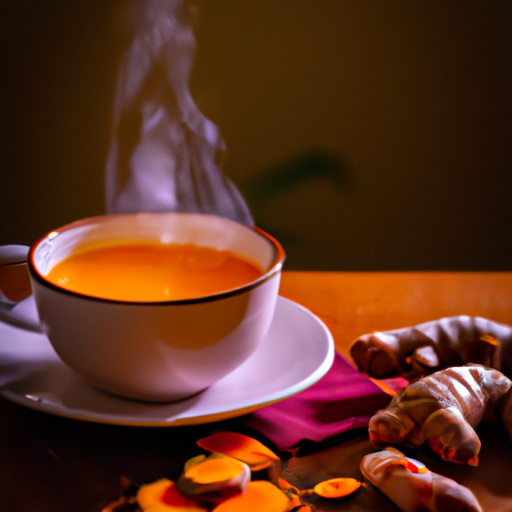You might be under the impression that preparing turmeric tea from scratch using fresh turmeric seems like quite the task. However, believe me when I say, the nutritional advantages and wonderful flavor make it entirely justified.
Turmeric is known for its anti-inflammatory properties and has been used in traditional medicine for centuries. By using fresh turmeric root, we can ensure that we are getting the full spectrum of health benefits from this magical herb.
In this article, I will guide you through the process of making turmeric tea using fresh turmeric root. Don’t worry if you’ve never worked with fresh turmeric before – I’ll explain everything step-by-step so that even beginners can follow along.
So put on your apron and let’s get started on creating a warm cup of goodness!
Key Takeaways
- Turmeric is known for its anti-inflammatory properties and has been used in traditional medicine for centuries.
- To prepare turmeric tea, peel and chop fresh turmeric root and steep in boiling water for 10-15 minutes. Optional ingredients like ginger, lemon juice, honey, and cinnamon can be added for taste and additional health benefits.
- Turmeric tea can be customized with variations like ginger-turmeric tea, lemon-turmeric tea, and honey-turmeric tea.
- Adding black pepper, lemon juice, ginger, cinnamon, or milk/coconut milk can enhance the health benefits of turmeric tea, such as boosting immunity, improving digestion, and lowering blood sugar levels. Turmeric also contains antioxidants and anti-inflammatory properties as effective as some prescription medications.
Gather the Ingredients
Now you’re ready to gather all the ingredients for your fresh turmeric tea! First and foremost, you’ll need fresh turmeric root. You can find this at many grocery stores or specialty markets. Make sure to choose a firm, unblemished root that has a bright orange color. Fresh turmeric has more flavor and nutrients than powdered turmeric, making it the perfect choice for this tea.
Next, you’ll need water and honey. Water is used as the base of the tea, while honey adds sweetness and helps to balance out any bitterness from the turmeric. You can also add other spices such as ginger or cinnamon if desired.
It’s important to note that there are many different ways to use fresh turmeric in cooking and drinks like this tea. Turmeric has been used for centuries in traditional medicine practices due to its anti-inflammatory properties and ability to boost brain function. Incorporating it into your diet in various ways can have numerous health benefits.
Now that we’ve gathered all our ingredients, let’s move on to preparing the turmeric root for our tea!
Prepare the Turmeric Root
First, peel the root using a sharp knife or vegetable peeler. Peeling fresh turmeric can be tricky because it has a thin skin that’s tightly adhered to the flesh. To make it easier, you can use a spoon to scrape off the skin instead of cutting it with a knife. Another technique is to soak the root in water for 10-15 minutes before peeling. This’ll soften the skin and make it easier to remove.
After peeling, chop the turmeric into small pieces. You can use a grater or food processor if you prefer. Remember that fresh turmeric stains easily, so wear gloves or use utensils that won’t get stained by its vibrant yellow color. Once chopped, put the turmeric in a small bowl and set aside.
Health benefits of turmeric are numerous and impressive. Curcumin, which’s found in high concentrations in turmeric, has been shown to have anti-inflammatory properties that may help reduce pain and swelling caused by various conditions such as arthritis or inflammatory bowel disease (IBD). Other potential health benefits include improving brain function and reducing the risk of heart disease.
Now that you’ve prepared your fresh turmeric root, it’s time to boil some water for your tea. Simply bring water to a boil on your stovetop or using an electric kettle.
Boil the Water
To get started, you’ll want to bring some water to a boil for your next step. Don’t forget to keep an eye on it so it doesn’t boil over! Boiling water is the first and most essential step in making turmeric tea using fresh turmeric. You can use filtered or tap water, whichever you prefer.
While waiting for the water to boil, let’s talk about the benefits of drinking turmeric tea. Turmeric contains curcumin, a compound that has anti-inflammatory and antioxidant properties. Studies have shown that consuming curcumin can help reduce inflammation in the body and improve brain function. Additionally, drinking turmeric tea regularly can boost your immune system and lower your risk of chronic diseases such as heart disease and cancer.
Now let’s move on to different ways to flavor turmeric tea once you’ve boiled the water. You can add honey, lemon juice, ginger or cinnamon for added taste and health benefits. Honey provides natural sweetness while also having antibacterial properties that can help soothe sore throats and coughs. Lemon juice adds a refreshing tangy taste while providing Vitamin C which boosts immunity. Ginger aids digestion while adding a spicy kick whereas cinnamon helps regulate blood sugar levels.
Next up: add the turmeric to the boiling water without delay!
Add the Turmeric to the Boiling Water
As I add the vibrant yellow spice to my boiling water, I’m pleased to know that turmeric has numerous health benefits. According to a study by the University of California, curcumin’s anti-inflammatory properties are as effective as some prescription medications. Turmeric is also rich in antioxidants and can help boost the immune system.
There are different ways to make turmeric tea using fresh turmeric. Some popular types include ginger-turmeric tea, lemon-turmeric tea, and honey-turmeric tea. Ginger-turmeric tea is great for digestion, while lemon-turmeric tea is refreshing and energizing. Honey-turmeric tea is perfect for soothing sore throats and coughs.
Adding optional ingredients can enhance the taste and nutritional value of your turmeric tea. Some great options include black pepper (which helps with curcumin absorption), cinnamon (which adds warmth and sweetness), and milk or coconut milk (which makes it creamier). Experiment with different combinations until you find your favorite blend!
Add Optional Ingredients
You don’t want to miss out on the opportunity to enhance the flavor and nutritional benefits of your turmeric tea by adding optional ingredients.
While turmeric tea alone can provide a variety of health benefits, you can further amplify its effects by incorporating other natural ingredients. For example, adding ginger or black pepper may help increase the absorption of curcumin, which is the active compound in turmeric responsible for its anti-inflammatory properties.
Other options for enhancing your turmeric tea include honey for sweetness and lemon juice for a tangy kick. You can also experiment with different herbs such as cinnamon or cardamom to create unique variations of this popular drink.
Not only will these additions create a delicious blend, but they also offer their own set of health benefits. Incorporating these optional ingredients in your turmeric tea allows you to enjoy not just one but multiple health benefits in every cup.
So now that you’ve added everything you need into your pot, it’s time to let the tea steep and bring out all those flavors!
Let the Tea Steep
Once the ingredients have been combined in your pot, allow the tea to steep and infuse all those delicious flavors. Steeping time is crucial to get the full benefits of turmeric. For optimal results, let the tea steep for 10-15 minutes.
The benefits of turmeric are numerous and well-known. Turmeric contains curcumin, which has potent anti-inflammatory properties that help reduce inflammation and joint pain. Drinking turmeric tea regularly can also boost your immunity, improve digestion, and lower blood sugar levels.
There are different types of turmeric tea you can make using fresh or powdered turmeric, such as golden milk or ginger-turmeric tea. Each recipe has its unique flavor profile and health benefits.
Once your tea is ready, it’s time to strain it to remove any bits of ginger or other optional ingredients that might be floating around in your cup.
Transitioning into the subsequent section about ‘strain the tea’, I’ll explain how to do this step without losing a drop of this delicious drink!
Strain the Tea
After letting the turmeric tea steep for a few minutes, it’s time to strain the tea. This step is important to remove any bits of ginger or turmeric that may not have dissolved in the water. Straining also helps to achieve a smooth and consistent texture.
To strain the tea, I use a fine mesh strainer placed over a teapot or mug. Alternatively, cheesecloth can be used as well. I pour the tea through the strainer into my cup, making sure to catch any loose pieces of turmeric or ginger that may have remained in the pot.
Some people choose not to strain their turmeric tea for added health benefits. The small pieces of turmeric and ginger left behind can provide extra fiber and nutrients. However, if you prefer a smoother texture, straining is recommended.
Now that our turmeric tea is strained and ready to drink, let’s move on to serving and enjoying this delicious beverage!
Serve and Enjoy
Ah, finally it’s time to savor the deliciousness of this golden elixir! Get ready for a flavor explosion as you take your first sip and feel the warmth spread throughout your body.
But turmeric tea isn’t just tasty, it also has numerous health benefits. Turmeric is known for its anti-inflammatory properties, making it a great choice for those with arthritis or other inflammatory conditions. It can also help boost the immune system and aid in digestion. Plus, turmeric contains antioxidants that can help protect against cancer.
There are many different ways to serve turmeric tea. Some like to add honey or lemon for an extra kick of flavor. Others prefer to drink it plain or with a splash of milk. You could even try adding some ginger or cinnamon for added health benefits and taste.
No matter how you choose to enjoy it, turmeric tea is sure to become a new favorite in your daily routine!
Frequently Asked Questions
What are the health benefits of turmeric tea?
When it comes to the health benefits of turmeric tea, there are plenty to consider. Turmeric tea is a natural anti-inflammatory, which can help reduce joint pain and swelling in conditions such as arthritis.
It also contains antioxidants that can protect against cell damage and may lower the risk of certain diseases like cancer and Alzheimer’s. Additionally, turmeric tea has been shown to improve digestion and boost the immune system.
While some people prefer taking turmeric supplements, drinking turmeric tea allows for more bioavailability of curcumin, the active ingredient in turmeric responsible for its health benefits. There are various recipes and variations of turmeric tea available online, so finding one that suits your taste preferences should be easy enough.
Overall, incorporating turmeric tea into your daily routine could lead to numerous health benefits and is a simple way to take advantage of this powerful spice’s properties.
Can I add sweetener to the turmeric tea?
After some research, I’ve found that adding sweeteners to turmeric tea is totally fine. However, it’s important to choose the right type of sweetener for your health concerns.
For example, if you’re looking for a natural option, you could try using raw honey or maple syrup. If you’re watching your calorie intake, stevia is a great low-calorie alternative. It’s also important to note that excessive consumption of sugar can have negative effects on overall health and may counteract the benefits of drinking turmeric tea.
As always, moderation is key when it comes to adding sweeteners to any beverage.
How long can I store the leftover turmeric tea?
After making turmeric tea using fresh turmeric, you may be wondering how long you can store the leftover tea.
It’s important to note that the freshness of the tea will start to diminish after a few hours. It’s recommended to consume or refrigerate any leftover tea within 24 hours of brewing it.
If left at room temperature for too long, bacteria can begin to grow and cause the tea to spoil. To ensure maximum freshness and taste, it’s best to make a fresh batch of turmeric tea each time you want to enjoy it.
Is it safe to consume turmeric tea during pregnancy?
As someone who’s researched extensively about the benefits and potential risks of consuming turmeric tea during pregnancy, I can say that it’s generally safe to consume in moderation. Turmeric has been used for centuries as a natural remedy for various ailments due to its anti-inflammatory and antioxidant properties.
However, it’s important to note that there haven’t been enough studies conducted on the effects of turmeric tea on pregnancy specifically. Some experts suggest limiting consumption to one cup per day or consulting with a healthcare provider before adding it to your diet.
Additionally, some research suggests that turmeric may have an impact on fertility by reducing inflammation and oxidative stress, which can help improve reproductive health. Overall, while there are potential benefits of drinking turmeric tea during pregnancy and for fertility, it’s important to approach with caution and seek advice from a medical professional before incorporating it into your routine.
Can I use powdered turmeric instead of fresh turmeric root?
Yes, you can definitely use powdered turmeric as a substitute for fresh turmeric root when making turmeric tea. In fact, using powdered turmeric is often more convenient and easier to find in grocery stores.
To make turmeric tea with powdered turmeric, simply mix 1-2 teaspoons of the powder into boiling water along with other desired ingredients such as honey or lemon juice. There are also many different recipes available online that incorporate both fresh and powdered versions of this spice, so don’t hesitate to experiment and find what works best for you.
However, it’s important to note that using too much turmeric can have negative side effects, so be sure to consult with your doctor before consuming large amounts of this spice during pregnancy or if you have any health concerns.
Conclusion
Well, folks, that’s all there is to it! Now you can impress your friends with your fancy turmeric tea-making skills.
But let’s be real here for a minute – does anyone actually enjoy the taste of this stuff? I mean, sure, it has some health benefits and all that jazz, but do we really need to subject ourselves to drinking what tastes like bitter dirt water?
I know there are some die-hard turmeric enthusiasts out there who will argue that the flavor is an acquired taste and that they genuinely enjoy sipping on this yellow concoction. To those people, I say more power to you.
But for the rest of us who would rather avoid drinking something that resembles liquid cardboard, maybe stick with adding turmeric to your food instead. Trust me, your taste buds will thank you.










